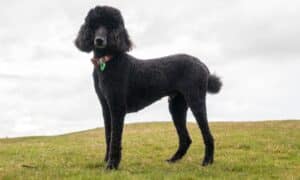“This post contains affiliate links, and I will be compensated if you make a purchase after clicking on my links.”
Are you considering Catahoula Leopard Dog adoption? These unique and striking canines are known for their distinctive coat patterns and strong work ethic.
At DogingtonPost, we’ve seen a growing interest in this breed among potential dog owners. However, before bringing a Catahoula into your home, it’s essential to understand their specific needs and characteristics.
Let’s explore whether this energetic and intelligent breed is the right fit for your lifestyle.
What Makes Catahoula Leopard Dogs Unique?
A Striking Appearance
Catahoula Leopard Dogs stand out with their distinctive features. Their coat often displays a merle pattern, swirling with colors like blue, red, or brindle. These medium to large-sized dogs typically weigh between 50 to 95 pounds and stand 20 to 26 inches tall at the shoulder.
Low-Maintenance Coat
The Catahoula’s short, smooth fur requires minimal grooming. A weekly brush usually suffices to keep their coat in top condition. (This low-maintenance aspect appeals to busy owners who lack time for extensive grooming routines.)
Strong-Willed Personality
Catahoulas possess a fierce loyalty to their families but often show wariness towards strangers. This protective instinct makes them excellent watchdogs. However, their independent streak can lead to stubbornness without proper training. Early socialization proves essential for a well-adjusted Catahoula.
High-Energy Demands
These dogs require at least one to two hours of vigorous exercise daily. A casual walk won’t cut it-Catahoulas need intense activities like running, hiking, or agility training. (Failure to meet their exercise needs can result in destructive behaviors.)
Mental Stimulation Requirements
Catahoulas excel in problem-solving and learn commands quickly. Their sharp minds demand constant challenges. Puzzle toys, training sessions, and varied activities keep their minds engaged and prevent boredom-related behaviors.
Training Challenges and Rewards
Training a Catahoula requires consistency and patience. Their intelligence facilitates quick learning, but their independent nature may lead them to challenge authority. Positive reinforcement techniques work best, as harsh methods can provoke resistance or aggression.
Working Dog Heritage
The American Kennel Club notes that Catahoulas originated as hunting and herding dogs in Louisiana. This heritage manifests in their strong work ethic and desire for tasks. Owners who provide activities that tap into these instincts often find their Catahoulas more content and well-behaved.
Living Space Considerations
While Catahoulas can adapt to various living situations, they don’t thrive in apartments or with sedentary individuals. Their high energy and space requirements make them better suited to homes with large, securely fenced yards for running and playing.

As we explore the unique traits of Catahoula Leopard Dogs, it becomes clear that they require a specific type of owner. Let’s now examine the advantages of adopting one of these remarkable canines.
Why Catahoula Leopard Dogs Make Great Companions
Unmatched Loyalty and Protection
Catahoula Leopard Dogs form deep bonds with their families. This loyalty translates into natural protective instincts. Many Catahoula owners report feeling safer with their dogs around. However, this protective nature requires proper socialization. The American Kennel Club recommends exposing Catahoulas to various people and situations from a young age to prevent overprotectiveness.
Versatile Working Partners
These dogs excel in various tasks due to their working heritage. Farmers and ranchers often praise Catahoulas for their herding abilities. (A 2020 survey by the Louisiana Farm Bureau revealed that 78% of Catahoula owners reported improved livestock management after introducing these dogs to their operations.)
Catahoulas excel in search and rescue operations. Their keen sense of smell and endurance make them valuable assets in wilderness searches.
Easy Grooming for Busy Owners
Despite their striking appearance, Catahoulas require minimal grooming. A weekly brush and occasional bath usually suffice. This low-maintenance aspect can be appealing to potential owners. Puppies typically cost around $600, while adult Catahoulas may cost up to $600.
Adaptability to Various Lifestyles
While Catahoulas thrive in active environments, they can adapt to different living situations with proper care. Urban dwellers who provide ample exercise and mental stimulation find these dogs can adjust well to city life. A study by the University of Pennsylvania’s School of Veterinary Medicine found that Catahoulas in urban settings showed similar satisfaction levels to those in rural areas when given adequate exercise and engagement.
Intelligent and Trainable
Catahoulas possess high intelligence, which makes them highly trainable. They excel in obedience training and can learn complex commands quickly. This intelligence, combined with their eagerness to please, allows them to perform well in various dog sports and activities. (Owners who invest time in training often report a stronger bond with their Catahoulas.)

While Catahoula Leopard Dogs offer numerous benefits as companions, it’s important to consider the challenges that come with owning this unique breed. Let’s explore some of the potential difficulties you might face when adopting a Catahoula.
Are Catahoula Leopard Dogs Too Much to Handle?
Catahoula Leopard Dogs offer unique challenges that potential owners must consider. These dogs demand significant time, energy, and resources. Let’s explore the potential difficulties of adopting a Catahoula.
Demanding Exercise Regimen
Catahoula Leopard Dogs are not recommended for apartment living due to their high energy level. They need at least one hour of vigorous exercise per day. This includes long runs, intense play sessions, or participation in dog sports like agility or herding trials.

Insufficient exercise can lead to destructive behaviors.
To keep a Catahoula happy and healthy, you must commit to a consistent exercise routine. This might involve earlier wake-up times for morning runs or dedicating significant time after work for play and training sessions.
Mental Stimulation Challenges
Catahoulas require substantial mental stimulation in addition to physical exercise. Their intelligence and problem-solving abilities cause them to become bored quickly with routine activities.
Owners find success in rotating through a variety of puzzle toys and interactive games. The Kong Company reports that Catahoulas rank among the top breeds that benefit from their durable, treat-dispensing toys.
Training sessions should occur frequently and vary to keep these smart dogs engaged. Many Catahoula owners succeed with clicker training, which allows for quick communication and rewards for desired behaviors.
Strong-Willed Nature
Catahoulas exhibit an independent streak, which can manifest as stubbornness during training. This trait, while valuable in their original working roles, challenges inexperienced dog owners.
Consistency proves key when working with a Catahoula. The American Kennel Club recommends early training initiation and maintaining a firm but positive approach. Harsh corrections can backfire with this sensitive breed, potentially leading to fear or aggression.
Many Catahoula owners succeed with reward-based training methods.
Prey Drive Management
The strong prey drive inherent in Catahoulas poses challenges, especially in multi-pet households or areas with wildlife. This instinct, while useful in their original hunting roles, can lead to chasing behaviors that put smaller animals at risk.
Proper socialization from an early age proves essential. Introducing your Catahoula to various animals in controlled settings can help mitigate their prey drive. However, some Catahoulas may never fully trust small pets or livestock.
Secure fencing is a must for Catahoula owners. The American Fence Association recommends a minimum fence height of 6 feet for containing high-energy breeds like the Catahoula.
Health Considerations
While generally healthy, Catahoulas are prone to certain genetic health issues. Hip dysplasia affects up to 20% of the breed according to the Orthopedic Foundation for Animals.
Regular veterinary check-ups enable early detection of potential health problems. The American Veterinary Medical Association recommends twice-yearly exams for adult dogs, with more frequent visits for puppies and seniors.
Deafness is another issue that can affect Catahoulas, particularly those with predominantly white coats. The Louisiana State University School of Veterinary Medicine reports that up to 30% of Catahoulas may have some degree of hearing loss.
Prospective owners should prepare for potential medical expenses. Pet insurance can help offset these costs, with many providers offering breed-specific policies that cover common Catahoula health issues.
Final Thoughts
Catahoula Leopard Dogs offer unique traits and challenges for potential owners. These striking canines require substantial exercise, mental stimulation, and consistent training. Their high energy levels and strong-willed nature may not suit every household, but they provide unwavering loyalty and companionship to those who meet their needs.

We at DogingtonPost encourage thorough research before considering Catahoula Leopard Dog adoption. Visit reputable breeders or rescue organizations to interact with Catahoulas and gain insights from experienced owners. This hands-on approach will help you determine if a Catahoula aligns with your lifestyle and expectations.
Numerous rescue organizations specialize in this breed and can provide valuable information throughout the adoption process. To learn more about responsible dog ownership and access canine-related resources, visit our comprehensive guide for dog lovers. We support you in making informed decisions about pet adoption and care. (Adopting a Catahoula requires dedication, patience, and understanding.)


















